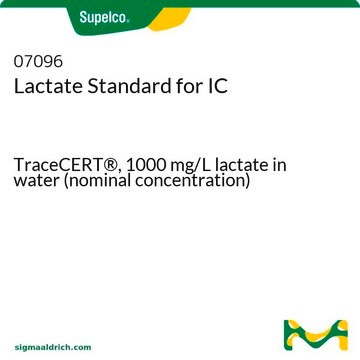Lactic acid is not considered a volatile material.
1356734
USP
Acido L-(+)-lattico
United States Pharmacopeia (USP) Reference Standard
Sinonimo/i:
Acido (S)-2-idrossipropionico, Acido sarcolattico
Scegli un formato
Scegli un formato
About This Item
Prodotti consigliati
Grado
pharmaceutical primary standard
Famiglia di API
lactic acid
Saggio
89.1% (lactic acid basis)
Produttore/marchio commerciale
USP
tecniche
HPLC: suitable
applicazioni
pharmaceutical (small molecule)
Formato
neat
Temperatura di conservazione
2-8°C
Stringa SMILE
C[C@H](O)C(O)=O
InChI
1S/C3H6O3/c1-2(4)3(5)6/h2,4H,1H3,(H,5,6)/t2-/m0/s1
JVTAAEKCZFNVCJ-REOHCLBHSA-N
Cerchi prodotti simili? Visita Guida al confronto tra prodotti
Descrizione generale
Applicazioni
Also, for use with USP monographs such as:
- Fumaric Acid
- Maleic Acid
Risultati analitici
Altre note
Prodotti correlati
Avvertenze
Danger
Indicazioni di pericolo
Classi di pericolo
Eye Dam. 1 - Skin Corr. 1C
Rischi supp
Codice della classe di stoccaggio
8A - Combustible corrosive hazardous materials
Classe di pericolosità dell'acqua (WGK)
WGK 1
Punto d’infiammabilità (°F)
235.4 °F - closed cup
Punto d’infiammabilità (°C)
113 °C - closed cup
Scegli una delle versioni più recenti:
Certificati d'analisi (COA)
Ci dispiace, ma al momento non ci sono COA disponibili online per questo prodotto.
Se ti serve aiuto, non esitare a contattarci Servizio Clienti
Possiedi già questo prodotto?
I documenti relativi ai prodotti acquistati recentemente sono disponibili nell’Archivio dei documenti.
I clienti hanno visto anche
Protocolli
Separation of DL-Lactic acid, ~90% (T)
Science Slam panel: Leading gene therapy developers discuss commercialization challenges and the importance of robust process development plans.
-
is it volatile
1 risposta-
Utile?
-
Filtri attivi
Il team dei nostri ricercatori vanta grande esperienza in tutte le aree della ricerca quali Life Science, scienza dei materiali, sintesi chimica, cromatografia, discipline analitiche, ecc..
Contatta l'Assistenza Tecnica.




